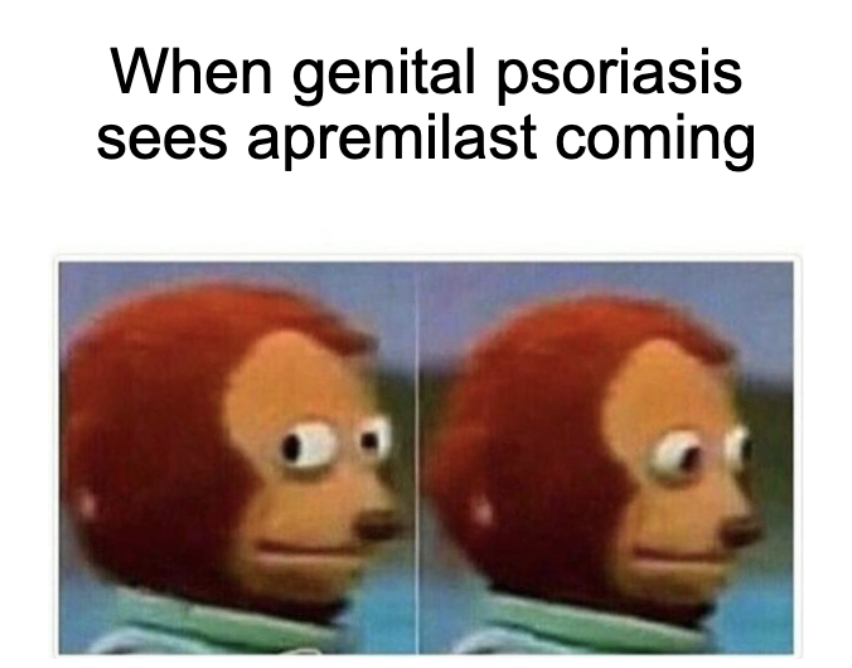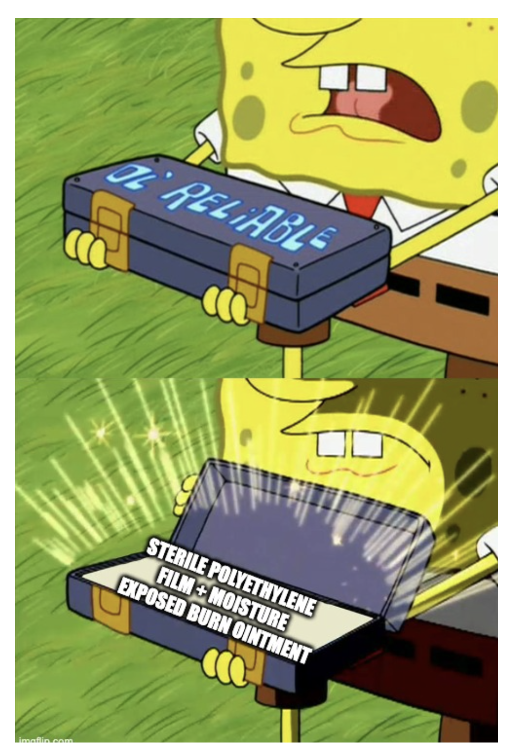Fifty-sixth issue
March 20, 2024
What factors affect the choice of treatment in patients with Hidradenitis Suppurativa?
JAMA Dermatology
JAMA Dermatology
So. Many. Choices. Where does one begin?
Hidradenitis Suppurativa (HS) is an inflammatory dermatosis that causes painful cysts and sinus tracts in intertriginous areas, with high impact on quality of life. While adalimumab and infliximab are first-line treatments for HS, one study found that only 1.8% of patients are prescribed either medication.
The objective of this qualitative study was to evaluate the decision-making process for treating HS in hopes of better understanding how to treat this patient population. Researchers conducted a series of open-ended, semi structured interviews of 21 adults with HS; nearly all were Hurley stage II or III, 71% of which previously used adalimumab.
What did they find?
Main Takeaway: Dermatologists can empower patients to make informed decisions about treatment of their HS by counseling patients about risk factors, benefits to treatment and need for early intervention to prevent further morbidity, and identifying gaps in knowledge about the disease itself.
Hidradenitis Suppurativa (HS) is an inflammatory dermatosis that causes painful cysts and sinus tracts in intertriginous areas, with high impact on quality of life. While adalimumab and infliximab are first-line treatments for HS, one study found that only 1.8% of patients are prescribed either medication.
The objective of this qualitative study was to evaluate the decision-making process for treating HS in hopes of better understanding how to treat this patient population. Researchers conducted a series of open-ended, semi structured interviews of 21 adults with HS; nearly all were Hurley stage II or III, 71% of which previously used adalimumab.
What did they find?
- Demographics: age 38.5 [27.9-43.4] years, 76% female, 71% Black, 19% White, 5% Asian, 5% Native Hawaiian/Pacific Islander
- 96% Hurley stage II or III
- Factors that affected decision-making in treating HS:
- Suffering threshold: as pain increased, patients were more willing to move from topical → oral → biologic therapy
- Some saw adalimumab as a last resort, opting to use after reaching physical and psychological threshold
- Some were averse to systemic medication, avoiding until symptoms were physically intolerable
- Some saw adalimumab as a last resort, opting to use after reaching physical and psychological threshold
- Perceptions of treatment risk
- Biologics: concern for lymphoma and infection risk dissuaded some
- Misconceptions about biologic therapies being hepato or renotoxic
- Oral therapy: AE from gastrointestinal side effects dissuaded some
- Surgery: high potential morbidity and prolonged recovery time
- Biologics: concern for lymphoma and infection risk dissuaded some
- Treatment fatigue
- Disease understanding
- Some felt they lacked knowledge of HS therapies
- Some had gaps in understanding HS as a chronic disease, influencing their management decisions
- Patients wanted dermatologists to discuss treatment options
- Some felt they lacked knowledge of HS therapies
- Sources of information (dermatologists, the internet, advertisements, family members…)
- Suffering threshold: as pain increased, patients were more willing to move from topical → oral → biologic therapy
Main Takeaway: Dermatologists can empower patients to make informed decisions about treatment of their HS by counseling patients about risk factors, benefits to treatment and need for early intervention to prevent further morbidity, and identifying gaps in knowledge about the disease itself.
Efficacy and safety of apremilast in patients with moderate-to-severe genital psoriasis: Results from DISCREET, a phase 3 randomized, double-blind, placebo-controlled trial
Journal of American Academy Dermatology
Journal of American Academy Dermatology
(apremi)BLAST genital psoraisis away!
Genital psoriasis is characterized by skin inflammation in the genital area and affects up to 63% of adults with psoriasis at some time. Genital psoriasis significantly affects a patient's quality of life and treatment is limited and often challenging. Apremilast, an oral phosphodiesterase-4 inhibitor, is FDA-approved for psoriasis across all disease severity levels and may be a promising potential treatment for moderate-to-severe genital psoriasis.
The DISCREET trial was a phase 3 randomized, double-blind, placebo-controlled study (n = 289), aimed to assess the efficacy and safety of apremilast in patients with moderate-to-severe genital psoriasis. Patients were randomized to receive either apremilast 30 mg twice daily or placebo for 16 weeks. The primary efficacy endpoint was the proportion of patients achieving a modified genital Physician Global Assessment (PGA) response, defined as a score of 0 (clear) or 1 (almost clear) with a ≥ 2 point reduction from baseline, at week 16.
What did they find?
Genital psoriasis is characterized by skin inflammation in the genital area and affects up to 63% of adults with psoriasis at some time. Genital psoriasis significantly affects a patient's quality of life and treatment is limited and often challenging. Apremilast, an oral phosphodiesterase-4 inhibitor, is FDA-approved for psoriasis across all disease severity levels and may be a promising potential treatment for moderate-to-severe genital psoriasis.
The DISCREET trial was a phase 3 randomized, double-blind, placebo-controlled study (n = 289), aimed to assess the efficacy and safety of apremilast in patients with moderate-to-severe genital psoriasis. Patients were randomized to receive either apremilast 30 mg twice daily or placebo for 16 weeks. The primary efficacy endpoint was the proportion of patients achieving a modified genital Physician Global Assessment (PGA) response, defined as a score of 0 (clear) or 1 (almost clear) with a ≥ 2 point reduction from baseline, at week 16.
What did they find?
- At week 16, 39.6% of patients in the apremilast group achieved a modified genital PGA response versus 19.5% of patients in the placebo group (treatment difference 20.1%, p = 0.0003)
- 22.2% of patients in the apremilast group achieved an overall static Physician Global Assessment response at week 16 versus 6.9% in the placebo group (treatment difference: 15.2%, p = 0.0004)
- The Genital Psoriasis Itch Numeric Rating Scale (GPI-NRS) response rate was higher in the apremilast group (47.3 vs. 19.6%; treatment difference 27.4%, p < 0.0001)
- The most commonly reported treatment-emergent adverse events were diarrhea, nausea, headache, and nasopharyngitis, consistent with the known safety profile for apremilast
Dominant dystrophic epidermolysis bullosa is associated with
glycolytically active GATA3+ Th2 cells which may contribute to pruritus in lesional skin
British Journal of Dermatology
glycolytically active GATA3+ Th2 cells which may contribute to pruritus in lesional skin
British Journal of Dermatology
Scratching that DDEB itch (with molecularly based drug therapies)
Dominant dystrophic epidermolysis bullosa (DDEB) is an inflammatory skin condition associated with glycolytically active GATA3+ Th2 cells, characterized by trauma-induced blisters and chronic itch. Although not yet specifically tested, some clinicians have observed that biologics may improve itch in patients with DDEB. In this study, the authors performed bulk and single cell RNA sequencing to identify genes and pathways involved in DDEB affected skin.
What they found:
Main takeaways: The authors utilized RNA sequencing to identify inflammatory pathways activated in DDEB. By better understanding these pathways, we can better design drug therapies. Future studies are required to better elucidate characteristics and possible functions of the DDEB-specific Th2 lymphocyte populations.
Dominant dystrophic epidermolysis bullosa (DDEB) is an inflammatory skin condition associated with glycolytically active GATA3+ Th2 cells, characterized by trauma-induced blisters and chronic itch. Although not yet specifically tested, some clinicians have observed that biologics may improve itch in patients with DDEB. In this study, the authors performed bulk and single cell RNA sequencing to identify genes and pathways involved in DDEB affected skin.
What they found:
- In DDEB, there was activation of T-cell related genes, specifically regarding the Th1/2 and Th17 pathways
- The authors identified a new Th2 lymphocyte population, which may be a potential target for new therapy development
- There was upregulation of Th2-associated RNA and protein markers in DDEB skin. This discovery may help in repurposing existing drugs that target Th2 for management in DDEB. In fact, treatment with dupilumab in 3 research subjects with DDEB revealed promising improvement in reported itch
Main takeaways: The authors utilized RNA sequencing to identify inflammatory pathways activated in DDEB. By better understanding these pathways, we can better design drug therapies. Future studies are required to better elucidate characteristics and possible functions of the DDEB-specific Th2 lymphocyte populations.
Are pediatric EB patients at a higher risk of developing compromised bone health?
Pediatric Dermatology
Pediatric Dermatology
EB patients have a ~bone~ to pick with osteoporosis!
Epidermolysis bullosa (EB) is a rare skin condition causing blistering and skin fragility. There are several subtypes of EB characterized by mutations in genes encoding proteins vital for skin integrity. EB is commonly associated with extracutaneous symptoms, including osteoporosis. Bone health in EB patients is impaired via several avenues, including chronic inflammation inducing a hypermetabolic state, GI complications limiting oral intake, vitamin D deficiency from malnutrition and limited outdoor exposure, and delayed puberty from abnormal maturation of the hypothalamic-pituitary-gonadal axis.
This scoping review of 21 publications aimed to provide further insights into the relationship of EB and osteopenia, osteoporosis, and pathologic fractures for better monitoring and treatment of bone changes.
What did they find?
Epidermolysis bullosa (EB) is a rare skin condition causing blistering and skin fragility. There are several subtypes of EB characterized by mutations in genes encoding proteins vital for skin integrity. EB is commonly associated with extracutaneous symptoms, including osteoporosis. Bone health in EB patients is impaired via several avenues, including chronic inflammation inducing a hypermetabolic state, GI complications limiting oral intake, vitamin D deficiency from malnutrition and limited outdoor exposure, and delayed puberty from abnormal maturation of the hypothalamic-pituitary-gonadal axis.
This scoping review of 21 publications aimed to provide further insights into the relationship of EB and osteopenia, osteoporosis, and pathologic fractures for better monitoring and treatment of bone changes.
What did they find?
- Growth and pubertal delays may be prevalent in EB patients (7/21), predominantly in severe types of EB like recessive dystrophic EB (RDEB) (6/21) and junctional EB (JEB) (1/21)
- Malnutrition is posited to contribute to growth delays and impaired bone health, and BMI Z-scores were notably lower in RDEB (-3.35 +/- 1.92) compared to other subtypes (-2.64 +/- 1.99)
- Vitamin D deficiencies were present by age 2 despite supplementation (54% in one study), often with other nutrient deficiencies in calcium, zinc, selenium, copper, and iron
- Malnutrition markers such as hypoalbuminemia (22-56% in one study depending on EB subtype) and anemia (91% in one study) were prevalent, especially in RDEB and JEB patients
- Vitamin D deficiencies were present by age 2 despite supplementation (54% in one study), often with other nutrient deficiencies in calcium, zinc, selenium, copper, and iron
- Bone mineral density (BMD) is consistently low in EB patients, particularly in RDEB (-2.32 +/- 1.34), with slower rates of bone mineral acquisition compared to healthy controls (-0.22 +/- 0.99)
- Immobility was a significant factor, with a higher risk of osteoporosis in wheelchair-bound patients (p = 0.069)
- Vitamin D supplementation and bisphosphonate treatment showed promising results in improving bone health markers and clinical outcomes in individual cases
- Immobility was a significant factor, with a higher risk of osteoporosis in wheelchair-bound patients (p = 0.069)
A new method for scald burn wound care to alleviate pain and allow for monitoring of wound healing
Journal of American Academy Dermatology
Journal of American Academy Dermatology
We’re “healing” good about this new scald burn wound care
A 3-year-old girl was involved in an accident that left her with a second-degree scald burn on her right cheek. Scald burn injuries in pediatric populations heal best with moist occlusive dressing, yet children often endure pain with dressing changes due to new granulation tissue formation.
It was hypothesized that this pain with dressing changes could be avoided with the use of sterile polyethylene film (Lifotronic) and moisture exposed burn ointment (MEBO). Sterile polythene is transparent, allowing for visualization of the wound as it is healing in addition to it being cost-effective and safe. With the use of this new dressing technique, the 3-year-old girl’s wound was healed with wound dressing changes every 2 days without any pain or discomfort.
What did they find?
Main takeaway: The use of sterile polyethylene film (Lifotronic) and moisture exposed burn ointment (MEBO) in scald burn wound care can alleviate pain at dressing changes and allow for monitoring of wound healing due to the transparent nature of the dressing.
A 3-year-old girl was involved in an accident that left her with a second-degree scald burn on her right cheek. Scald burn injuries in pediatric populations heal best with moist occlusive dressing, yet children often endure pain with dressing changes due to new granulation tissue formation.
It was hypothesized that this pain with dressing changes could be avoided with the use of sterile polyethylene film (Lifotronic) and moisture exposed burn ointment (MEBO). Sterile polythene is transparent, allowing for visualization of the wound as it is healing in addition to it being cost-effective and safe. With the use of this new dressing technique, the 3-year-old girl’s wound was healed with wound dressing changes every 2 days without any pain or discomfort.
What did they find?
- 3-year-old presented with second degree burns from direct contact with boiling water on the right cheek and anterior chin
- The burn underwent ultrasound debridement and then subsequently covered with moisture exposed burn ointment
- The burn was dressed with a layer of sterile polyethylene film that was changed every two days
- At the patient’s 1 year follow-up the results showed no significant scarring or dyspigmentation, proving to be an effective method for scald burn wound healing
Main takeaway: The use of sterile polyethylene film (Lifotronic) and moisture exposed burn ointment (MEBO) in scald burn wound care can alleviate pain at dressing changes and allow for monitoring of wound healing due to the transparent nature of the dressing.
Warts are verrucous, exophytic lesions caused by human papillomaviruses (HPVs) that slip through disrupted epithelial barriers to infect basal keratinocytes. Intralesional therapies are an emerging and effective approach for treating recalcitrant warts, particularly those in palmoplantar and periungual areas, which often exhibit resistance to conventional treatments.
The prevalence of recalcitrant warts presents a significant challenge for clinical dermatologists due to the absence of an FDA-approved treatment and lack of consensus on the most effective intralesional therapy. Therefore, our team aimed to characterize the efficacy and adverse events of commonly reported intralesional therapies. A systematic review was performed on 62 randomized controlled trials (RCTs) of intralesional therapies for cutaneous warts.
Results:
While over 500 articles pertaining to intralesional therapy of warts were identified, less than 10% were RCTs, and furthermore, even the most common treatment studied, MMR, had fewer than 1,000 patients across all trials. The limitations in generalizability of these findings suggest a significant gap in high-quality, large-scale research.
This study identified the need for more robust multi-institutional RCTs to establish a stronger evidence base for intralesional wart treatments, with an eventual goal of standardized intralesional treatment regimens in children and adults.
The prevalence of recalcitrant warts presents a significant challenge for clinical dermatologists due to the absence of an FDA-approved treatment and lack of consensus on the most effective intralesional therapy. Therefore, our team aimed to characterize the efficacy and adverse events of commonly reported intralesional therapies. A systematic review was performed on 62 randomized controlled trials (RCTs) of intralesional therapies for cutaneous warts.
Results:
- The most studied intralesional therapies included Mumps, Rubella, Varicella (MMR) vaccine (n=24 studies), purified protein derivative (PPD) (n=19), vitamin D3 (n=15), and Candida antigen (n=14) with complete response (CR) rates of 27-90%, 45-87%, 40-96%, and 25-84%, respectively
- Side effects were mostly limited events, most commonly injection site reactions and flu-like symptoms
While over 500 articles pertaining to intralesional therapy of warts were identified, less than 10% were RCTs, and furthermore, even the most common treatment studied, MMR, had fewer than 1,000 patients across all trials. The limitations in generalizability of these findings suggest a significant gap in high-quality, large-scale research.
This study identified the need for more robust multi-institutional RCTs to establish a stronger evidence base for intralesional wart treatments, with an eventual goal of standardized intralesional treatment regimens in children and adults.






